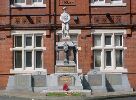
Newton-le-Willows and
Earlestown War Memorial

| OTHER WARS |
 |
Newton-le-Willows andEarlestown War Memorial |
 |
| The
Great War Roll of Honour |
|||||||||||||||||||||||||
James Anders enlisted with the Royal Garrison Artillery on 9th December 1915 "for the duration of the War". He was on General Service until he was posted on 18th July 1916. He was at that time living at 38, Bank Street in Earlestown with his wife, Mary Alice, nee Savage, who he had married on November 3rd 1912. James appears to have called his wife Alice, though she signed herself on papers after James's death as Mary Anders. They had no children.
Standing five feet seven inches tall, James was 28 when he enlisted and worked as a traveller and head assistant with Mr. T. Gregory, a grocer of Earlestown. He had two brothers, George and Hector who lived with their father, William Anders, at 345, Hyde Road, Gorton, although Soldiers Died in the Great War states that James was born in Rochdale.
He embarked for France from Southampton on 6th December 1916, arriving in Le Havre on the next day. James managed to earn himself "3 days Field Punishment No. 2" on 4th February 1917 "for whilst on Active Service Wilful damage to Private Property."
James was with 212th Siege Battery of the RGA. Artillery units frequently shelled each other, and James was killed by a shell, according to a letter sent to his wife by Lt. D. R. Macarthur.
James's grave is in Bully-Grenay Communal Cemetery, British Extension, which is about twenty kilometres north of Arras. Being in Plot I, he was originally buried here, although many of the over 750 1914-18 graves were concentrated here from smaller burial grounds after the Armistice.
Mary Alice's address given on the "burnt documents" connected with James's death, obtained from the Public Record Office, Kew, was 160, Earle Street, Earlestown, then as 24, Water Street, Newton-le-Willows. She was awarded a widow's pension of thirteen shillings and nine pence per week.
A Private Jonas Anders, 19975, of the 1st Battalion South Wales
Borderers was also born in Newton, Lancashire, and enlisted in Warrington,
according to “Soldiers Died in the Great War”. He was killed in
action on 27th August 1916. However there is no obituary, and no other references
to him in local papers, so it is unlikely that this is the J. Anders on the
Memorial.